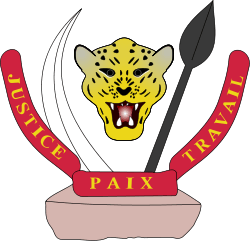Transitional Government of the Democratic Republic of the Congo
Part of a series on the |
||||||||||||||||||
|---|---|---|---|---|---|---|---|---|---|---|---|---|---|---|---|---|---|---|
| History of the Democratic Republic of the Congo | ||||||||||||||||||
 | ||||||||||||||||||
|
||||||||||||||||||
|
| ||||||||||||||||||
The Transitional Government of the Democratic Republic of Congo was tasked with moving from the state riven by the Second Congo War (1998-2003) to a government based upon a constitution agreed on by consensus. In 2001 President Laurent Kabila was assassinated and his son Joseph Kabila was named head of state.
In October 2002, Joseph Kabila negotiated the withdrawal of Rwandan forces occupying eastern Congo. Two months later, the Pretoria Accord was signed by all remaining warring parties to end the fighting and establish a government of national unity. The transitional period came to end with the completion of the 2006 general election and the swearing in of Kabila as President on 6 December 2006.
A transitional government was set up in July 2003; Joseph Kabila remains as president and now has four vice presidents representing the former government, former rebel groups, and the political opposition.
On 30 June, a transitional government composed of the various groups of the Inter Congolese Dialogue was formed. Over the course of September, a reinforced MONUC presence carried out the "Bunia, weapon-free zone" operation to demilitarize the province. They were partially successful, though a low-grade conflict continues to permeate the region.
See also
- 2000s in the Democratic Republic of the Congo
- Transitional National Assembly of the Democratic Republic of the Congo
External links
- International Center for Transitional Justice, Democratic Republic of the Congo
- Global and Inclusive Agreement on Transition in the Democratic Republic of the Congo, signed in Pretoria, South Africa on 16 December 2002
- CIA World Factbook
- Chiefs of State and Cabinet Members of Foreign Governments - DRC
- United States Holocaust Memorial Museum - Ripples of Genocide: Journey through Eastern Congo, testimonials from foreign visitors from 2002 and 2003